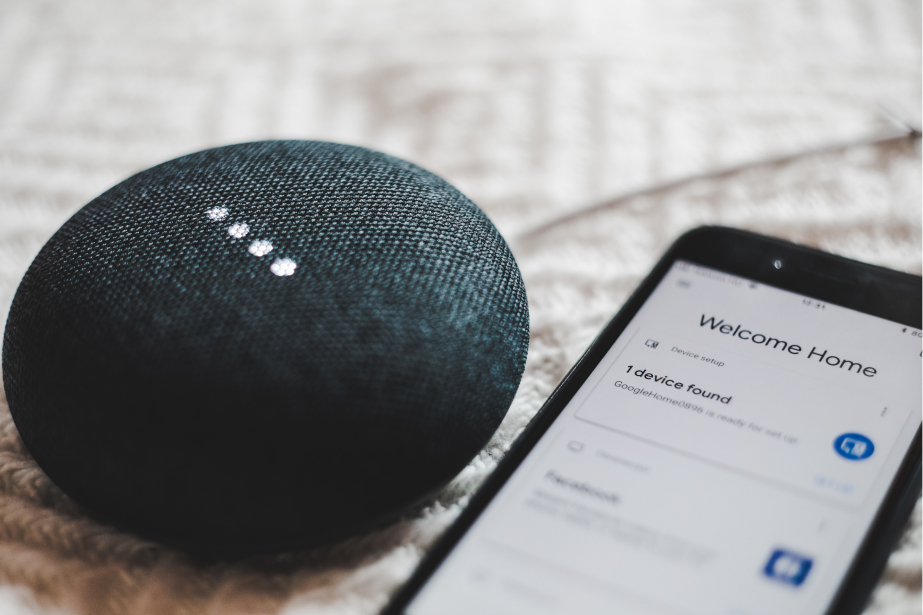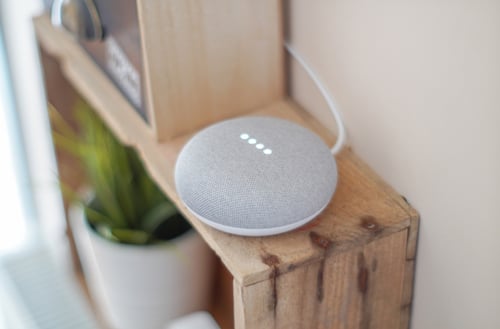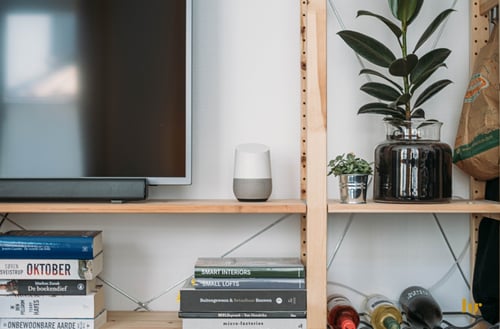
What do today’s customers need from customer service? For starters, they expect immediacy: 98% believe waiting times via phone or chat are too long. They also want more autonomy: 72% would rather look for answers online instead of contacting customer service for help.
So, how can brands and businesses provide a customer service experience that achieves this? By implementing customer self-service tools that both reduce customer support contact rates and ensure high-quality responses.
One tool that does both is a chatbot. In fact, it has been estimated that more than 80% of businesses today have automated their customer service conversations in some way. Chatbot technology has played a major role in this and, given the rise of advanced speech recognition software, we anticipate voice bots will become the future of customer service and is not just the latest customer service trend.
What are voice bots? How do they work? And what role will they play in the future of customer service? We will answer all of those questions here.
What are voice bots?
A voice bot (or voice assistants) is a conversational ai agent capable of communicating with a customer via voice alone.
Voice bots can ingest, analyze, interpret, and respond to customer inquiries spoken to them in natural language (or NLP), with the end goal of either being able to answer a customer’s question in real-time or continue a verbal exchange with the customer to clarify the question at hand. If the voice bot is unable to answer a question for any reason, it can pass the inquiry onto a human agent for additional support.
What is the real difference between chatbots and voice bots?
More and more companies are using chatbot technology as part of their overall customer service experience today. In fact, based on a recent Juniper Research study, chatbots are projected to drive cost savings of over $8 billion per year by 2022 in the banking and healthcare sectors alone.
Why? To transform the customer service experience through conversation especially with natural language processing (NLP) chatbots. By simulating real-life human interactions through chat- or voice bots, businesses can further streamline the customer journey and reduce the number of support requests to the contact center.
In many ways, the rising popularity of AI natural language processing chatbots is merely a precursor to the forthcoming pervasiveness of voice bots in the customer service experience. After all, they both serve the same purpose: to engage customers in dynamic and highly personalized conversations around getting answers to their questions. The only difference: one interacts via messaging while the other engages purely through voice ai.
The biggest difference between voice bots and chatbots, however, is that voice bots specifically require added speech recognition and speed synthesis capabilities. Not only do voice bots need to understand customer requests, but they also must be able to discern the intent of the question. This is critical for providing an accurate response.
Additionally, voice bots must be able to access information about the customer who’s asking the question—whether it be that person’s gender, age, past purchases, and other information in the customer profile—to be able to provide more relevant and personalized responses as well.
To do this, voice bots must be able to synthesize a voice request, which then becomes converted into text for processing, in order to provide an accurate vocal response in return—all within a matter of seconds.
Lastly, the biggest benefit of voice bots is their inherent accessibility: inputting a request can be 100% hands-free, without ever needing to input text manually. And seeing how voice search, for example, is becoming a bigger trend among consumers, it only makes sense that voice-based customer support, through voice bots, will follow that same trajectory.
Why brands are so interested in voice bots
Voice bot use amplified by connected devices
The rapid progression of speech and voice recognition technologies has caught the attention of several large companies, including Google, Apple, Microsoft, and Amazon globally as well as Baidu, Xiaomi, and Aliababa in China. They all anticipate that the voice assistant market will be driven by the widespread adoption of connected devices, which is expected to be a $20+ billion market over the next five years.
As of now, the biggest drivers of speech and voice recognition connected devices in the market are Google Nest (formerly known as Google Home) and Amazon Alexa—with new entrants in the marketing popping up each day.
Voice bot use driven primarily by younger consumers
The popularity and adoption of voice bots, across a number of use cases, including customer support, has been driven almost entirely by younger generations. In fact, 51% of consumers aged 14-17 have said that they’ve already interacted with a speech or voice recognition interface or device. This drops to 38% for consumers aged 18-34, 27% for consumers aged 35-55, and only 15% for consumers 55 years and older.
The generational divide tells us a lot about the wants, needs, and expectations of today’s consumers. Younger consumers, for example, those who have grown up in the digital age, likely find the act of manually typing in requests to be outdated. Of all generations, they are the consumers who value immediacy and instant gratification over everything else.
The popularity of giving simple voice commands to get the answers or information they need is merely part of this mindset. This is also a big reason why many brands and businesses are making it possible to engage with customers—and even allow them to make purchases—through advanced voice-enabled technologies. Businesses must respond to these changing consumer behaviours by digitalising their customer service strategy.
Voice search and the future of SEO
The entire world of SEO will be fundamentally changed if voice search becomes the new norm.
Today, when you input a request into the Google search box, you are provided with a list of answers organized by their perceived relevance. With voice search, however, people will no longer be given a choice between several answers; they will be provided by what the search engine—through advanced algorithms, artificial intelligence (AI), and machine learning—deems to be the best answer.
This means that brands will no longer compete to appear on the first Google search results page but rather, will be forced to fight head-to-head to land in the top spot (“position zero” in SEO terms).
You may have also seen a box filled with information appear before the list of search results. This is known as the “rich snippet” and is commonly referred to as the “Holy Grail” of SEO experts. In voice search, brands will have to focus their efforts to secure this position at all costs.
Additionally, contextualization will become a growing question around voice search. This comes at a time when 46% of voice searches are used to find a local business. For example, imagine it’s lunchtime, and you need to find a place to eat. Voice search will provide only relevant suggestions within the immediate vicinity—and not somewhere else across town. This makes the local SEO surrounding those business listings even more important, which, in turn, makes it possible for search engines to provide consumers with only the most contextually relevant responses possible.
Lastly, if queries are being submitted by voice, the onsite content must, therefore, be conversational in nature, too, in order to make it to the top spot in voice search results. This is an example of tailoring your content to how consumers are searching for what your business offers.
The increasing popularity of voice search—and its impact on how consumers now find and take action on information—is an indicator as to why voice bots will play a bigger role in the overall customer experience in the near future. However, what role will they play in customer service exactly?

What do voice bots bring to the customer service experience?
Voice bots meet new customer needs
Customer satisfaction is a perennial challenge for every business. The best way to achieve it is by providing customer support and support solutions that meet the needs of your customers. And if you remember from earlier in this article, those needs typically revolve around immediacy and autonomy.
Voice bots undoubtedly provide an advantage in terms of immediacy, purely in how they help customers avoid having to type in a question or request. If you look at it by the numbers alone, on average, people can type 53.5 words per minute on a standard keyword whereas they can speak around 161 words per minute—more than triple the number of words they can type! Therefore, you could say that voice bots live up to their promise of creating real-time customer support interactions with little to no downtime.
In terms of autonomy, on the other hand, voice bots are essentially customer self-service tools. This means they help reduce the number of contacts into human customer service agents via email, phone, or chat. It also can help customers with certain disabilities—those who have trouble reading small type on a screen or typing on their keyboard or phone—to be able to find the information they need in the easiest way possible.
Voice bots are accessible at any time
Customers can interact with chatbots and voice bots to get help at any time of day and whenever they need it most. This avoids having to wait on the line to speak with a customer service agent or being forced to call in during call center business hours. The immediacy of these bot-driven interactions can improve the overall customer service experience dramatically.
Additionally, voice bots allow customers to get the support they need while doing multiple things at once, making them the perfect multi-tasking customer support tools. Because they enable customers to engage in a customer service interaction purely via voice-driven commands—versus having to be attentive to the customer service agent’s questions over the phone or having to type in responses in a chat-based conversation—voice bots make it feasible to deal with customer support matters while going about daily life, whether you’re in the kitchen cooking or at work in the middle of a meeting.
Voice bots can personalize the customer relationship
Voice-based interactions create new opportunities for personalization. For example, through voice recognition, voice bots can know whether they are speaking with a man or a woman. And like ai chatbot, voice bots can quickly authenticate the customer and tap into the information within a customer’s profile to tailor their responses based on a customer’s history with a brand.
Because speaking is conversational by nature, voice bots also have the capacity to add a new user-friendly dimension to the customer service experience. After all, we, as humans, tend to be more spontaneous in our verbal interactions than we are in our more premeditated text-based interactions. This can lead to a more positive overall customer support interaction, albeit purely through technology, that helps customers get more accurate and precise answers, fast.
Voice bots know when to pass the baton
Despite how advanced and intelligent voice bots may be, there will inevitably be times when they don’t have all the answers. Of course, providing simple, FAQ-based answers—such as business hours, return policies, and the like—is what both voice bots and chatbots do best. They can tap into a central knowledge base to surface responses to these types of questions quickly and easily.
For more complex inquiries, however, if they haven’t been successful at addressing a customer’s need through the automated response workflow, they are smart enough to know when to pass off the customer to a living, breathing customer service agent to resolve the issue.
However, because chatbots and voice bots are powered by artificial intelligence (AI) and machine learning, even when they are not able to provide the response a customer needs, they learn from these interactions and begin to contextualize future responses based on these interactions. In other words, they are always learning and always seeking ways to provide customers with a better experience.
Voice bots lower the customer service contact rate
This is probably the biggest benefit that chatbots and voice bots bring to businesses: they help optimize resources and reduce expenses by reducing the overall customer service contact rate through the automation of simple customer service interactions that do not truly require human intervention. This, in turn, frees up customer service agents to dedicate their time and energy to dealing with more complex issues or inquiries (which is what they should be doing anyway).
According to McKinsey, human customer support interactions will be reduced by 30% in the next two years. This essentially means that chatbots and voice bots have the potential to own up to 70% of these interactions in the future.
This isn’t to suggest that humans will become obsolete in the customer service experience. Quite to the contrary, the combination of humans and smart customer support solutions, like chatbots and voice bots, will add greater value, speed, and efficiency to the customer service experience like never before.
Artificial intelligence (AI) is quickly revolutionizing the customer service experience. Voice bots, building on the momentum created by chatbot technology, are poised to become a new standard in customer service very soon. The big question is: are you ready to adopt voice bots into your customer service efforts?


.png)



